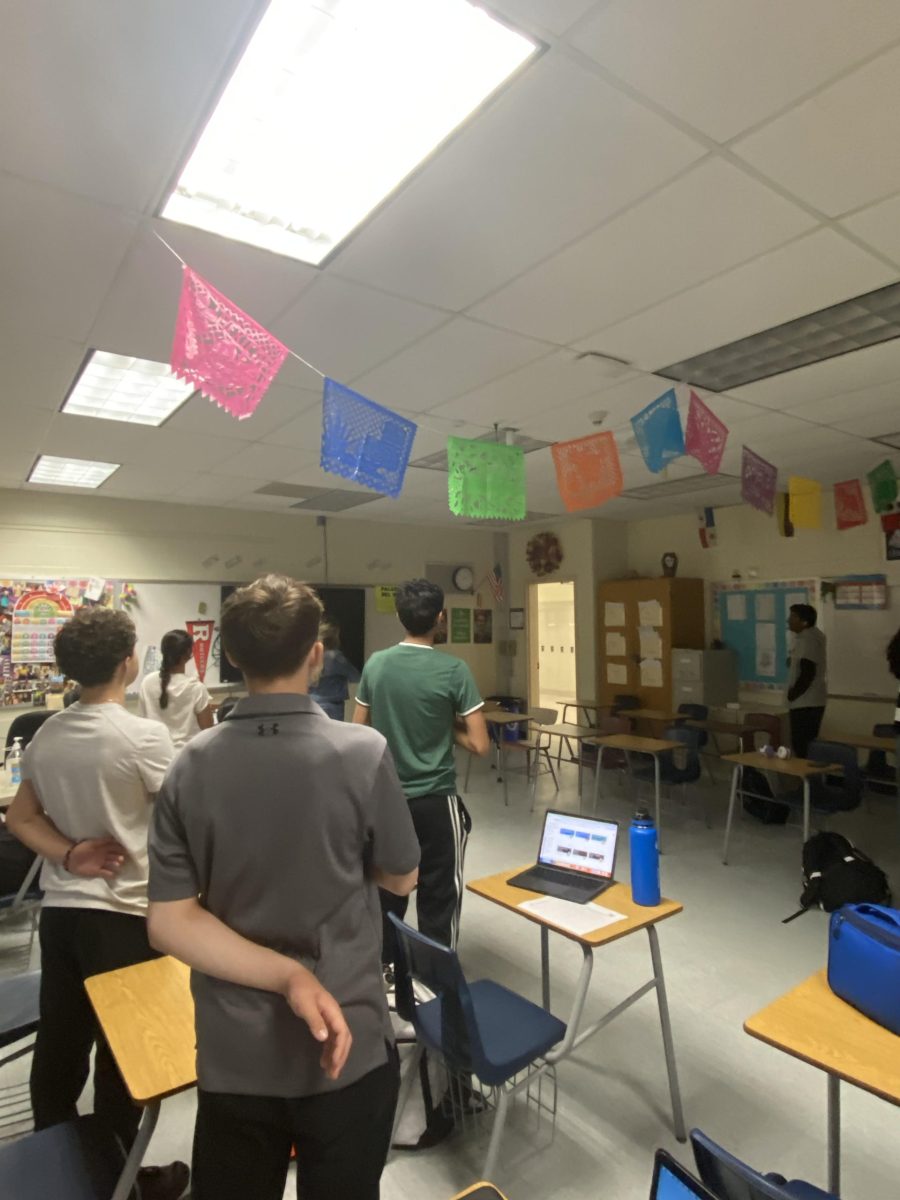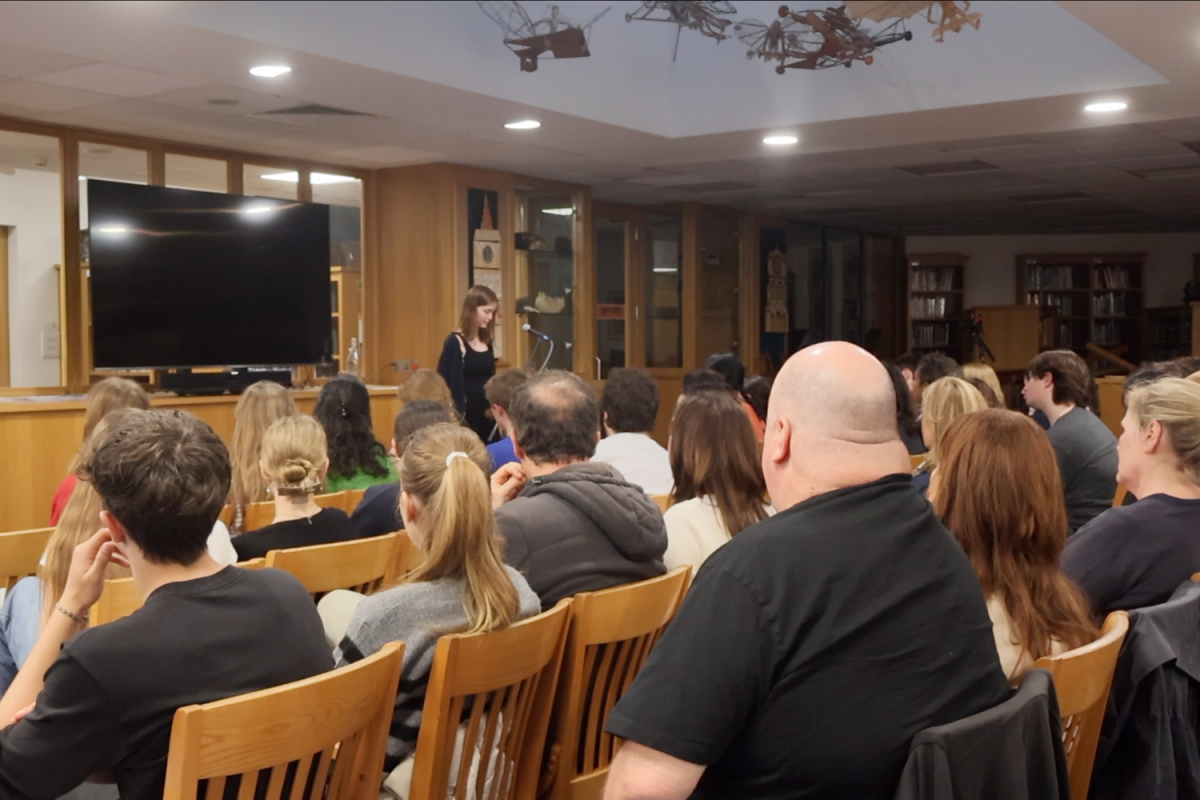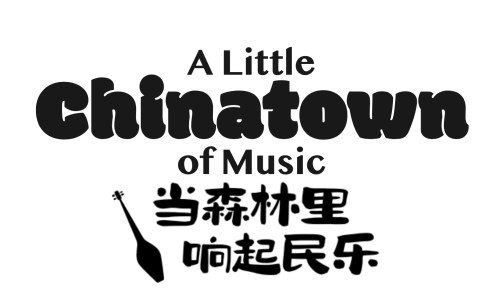It’s 1973 in Harbin, China. Meimei Wan stood beside her music teacher’s harmonium, feeling the ebbs and flows of the wind sent by foot-operated bellows. Something stirred in the 8-year-old girl’s heart, urging her to sing along with the lyrics and dance her fingers on the keys.
Fifty years later, Wan is taking her first Chinese instrument lessons in the United States taught by Wake Forest students in Winston-Salem, North Carolina. Before this, she had been learning alone, trying to recall scores from her distant musical training memory.
Now in class, she is getting the hang of playing the notes that give voice to her cherished lyrics, surrounded by fellow Chinese music enthusiasts who hail from different regions of China and span generations.
The Teachers
Wake Forest students Hongqing “Ives” Xue, Jing Chen and Yiyi “Luna” Bai arrive at Speas Global Elementary School, which houses the Sunday Class of Wen Hua Chinese School, with their guzheng and several bamboo flutes in tow. The late February afternoon sun casts a warm glow into the school hallways as they rush to their classroom. The three whisper in Mandarin, “We mustn’t be late for our students!”
Their students, Winston-Salem residents who have lived here for more than a decade, are waiting in the classroom with their guzhengs — a traditional Chinese zither played by plucking the strings, much like playing the piano keys — sitting on the floor in front of them. Their faces light up as they welcome their teachers.
“We’re thankful for the Wake Forest students who invest their time in teaching us,” Wan said.
In the guzheng and flute class, Xue and Chen taught popular tunes such as the theme song from the Chinese fantasy adventure anime movie “Big Fish & Begonia”, while Bai focused on teaching Chinese dance to approximately 10 children. In early February, both groups are getting ready for their annual performance at the Chinese New Year Gala for members of Wen Hua Chinese School, and everyone is putting their heart into it.
Chen’s guzheng class has five students: four elderly Chinese women and one Chinese-American girl, whose mother helps out as a translator and supervisor. Before starting the rehearsal, Chen stops by each guzheng, adjusting the strings with a tuner and tweaking the nails for a uniform tone.
In class, Chen wears active clothes, with clean-cut ponytails peeking out from her baseball cap. She speaks in a quick, expressive tone, eager to instill more skills into her students,
With an iPad displaying the score and a pair of scissors as a metronome, Chen initiates the rehearsal by tapping on the desk. The group starts plucking the strings, creating individual notes that blend into a flowing melody.
The musicians fixed their eyes on their instruments, gently pulling the strings and exploring the diverse sounds produced by each of the 21 strings. Occasionally, a wrong note would be struck, causing a minor hiccup, but the group brushes it off with laughter.
“My students aren’t looking for mastery of the instrument,” Chen said. “They just want to play folk music together out of their passion.”
Indeed, anyone familiar with the guzheng would recognize the group as a rookie class. Yet the serene expression on each student’s face makes it seem like they are training professionals.
Halfway through the class, Xue leads his three flute students into the classroom for a joint rehearsal. Chen gracefully sweeps the strings, setting a melancholic tone with scales. The high-pitched flute, led by Xue and echoed by his students, swiftly chimes in, complemented by the deep tones of the guzheng.
Far away from home, these Chinese students were rediscovering their cultural heritage through the familiar tunes played on traditional Chinese instruments, while connecting with members of the ethnic diaspora who yearn for the nostalgic lyrics of their roots.
On the evening of Feb. 25, the group took the stage in the Speas Elementary auditorium. Women wore red mandarin gowns known as Qipao, while men donned black suits. The audience, mostly of Chinese heritage, filled the seats and showered them with rounds of applause and cheers after the last note struck.
“We have a sizable Chinese community here,” Xue said. “Offering kids an opportunity to explore Chinese culture would be really valuable.”
Assembling the Ensemble
Xue and Chen are part of the Wake Forest University Chinese Ensemble, a musical group formed in 2016 by Gui Li (‘20), a Chinese international student at Wake Forest who brought her guzheng all the way overseas, sensing the lack of Chinese music representation on campus.
During her high school years in Michigan, Li spent four years playing the pipa — a pear-shaped wooden instrument also known as the “Chinese lute.” Every year at her high school’s talent show, she stood alone in the “non-western instrument” category and took home the win each time without any competition.
“When I arrived at Wake Forest, I had a desire to do something similar,” Li explained.
Inspired by her father, a magazine editor with a passion for ancient Chinese culture, Li was driven by the mission of “sharing the beauty of Chinese cultural heritage in America.”
In her first year, she met other Chinese students who played erhu and guzheng.
“It was like a casual chat that led to the discovery that we all had these instruments,” Li recalled. “That’s when we began the journey of forming an ensemble.”
Ziyi Geng, Assistant Teaching Professor at the Department of East Asian Languages and Cultures who currently serves as an advisor to the ensemble, recognized the ensemble as the sole ambassador of Chinese folk music not only within the university but also across Winston-Salem, High Point and Greensboro.
“The ensemble’s growth is truly impressive, ” Geng said. “The students’ initiative led to their recognition by the university.”
The ensemble typically rehearses once or twice a week to prepare for their end-of-semester performance. These rehearsals often include a mix of contemporary songs and timeless classics beloved by Chinese folk music enthusiasts. This semester, they’re joining forces with the Chinese Dance Club for a rendition of the song “The History” (浮光). They’ll mix the vibrant sounds of guzheng, the sharp notes of dizi (Chinese flute) and the rhythmic thuds of tanggu (Chinese drum) with the melodious strains of a cello, portraying historical transitions.
The ensemble members are recruited by signing up for a one-credit class, MSC 151. At its peak in 2019, the ensemble comprised 16 students playing instruments like guzheng, pipa, erhu, dizi and tanggu, among others. In the fall of 2021, the ensemble also featured a creative combination of Western instruments like guitar and piano.
“If we want Westerners to appreciate Chinese music, blending styles is inevitable,” Chen said. “Similar to Chinese cuisine — authentic dishes are rare here. To reach a broader audience, it needs a transformation, like General Tso’s chicken.”
“General Tso’s chicken” is an Americanized Chinese food that is often scoffed by Chinese students. To compare something to General Tso’s chicken is to say that it is Westernized. Yet, Chen’s compromising ideal is grounded in reality. Despite the ensemble being a sizable group, the average Chinese orchestra typically consists of 20 to 100 members, but the university only enrolls 200 to 300 Chinese students annually, making it a challenging feat to maintain the ensemble’s vitality.
Facing Dissonance
In 2019, the ensemble faced a significant setback when many seniors graduated and the group struggled to recruit. The group managed to arrange concerts, albeit with modest attendance. The year 2020 saw the ensemble grind to a halt due to the COVID-19 pandemic. Many incoming students were stuck in their home countries, resulting in a mix of mostly American students with Yujia “Alice” Cai and a few other Chinese students in the ensemble.
“It felt different, not quite like our usual Chinese ensemble,” Cai said.
Their typical flexibility in adjusting pieces based on the moment and instrument availability had to be set aside for adhering to the score to ensure unity among American and Chinese members. The result was beyond Cai’s expectations: they posted several pieces online for a unique pandemic-era remote concert.
With the waning of COVID-19 and the arrival of Wake Forest’s class of 2024 and 2025, the ensemble swiftly recovered.
Geng saw no decline in members’ enthusiasm as she assumed mentorship from Dr. Xijinyan Chen, Assistant Teaching Professor at Wake Forest Graduate School of Arts and Sciences, who is on leave this semester.
“As soon as the members returned to campus, the ensemble was revived, and it has since grown larger with the addition of new incoming students,” Geng said.
In November 2021, the ensemble held its first live concert after COVID-19 with the Wake Forest University Gamelan Giri Murti, showcasing traditional tunes like “Butterfly Lovers” and “Music of the Heavenly Palace,” along with popular covers like “Carrying You” from the anime “Castle in the Sky” and “Sun Quan the Emperor,” a hit on China’s social media in 2015.
But Chen noticed a gap amidst the vibrant cultural scene. While people showed interest in indigenous music, it wasn’t enough to keep them engaged throughout performances, resulting in a modest audience turnout.
Every child, regardless of their background, should have the opportunity to experience playing these instruments
— Ziyi Geng
“After the Gamelan Giri Murti performance, nearly half of the audience stood up and left,” Chen said. “I felt quite awkward onstage.”
Xue echoed the sentiment, but he also said that certain music forms might be too traditional for Western audiences to understand without integration.
“For dizi, it will be really hard to work with another Western instrument as they just cannot play certain songs,” Xue said.
Despite challenges, culture can transcend borders. Geng recalled performing traditional Chinese songs like “Colorful Clouds Chasing the Moon” at Brookberry Farm senior living community, predominantly attended by elderly white individuals.
Geng chuckled as she recalled that afternoon.
“They sat so quietly, those gray-haired grandpas, completely absorbed. After our performance, they had numerous questions: What’s the name of that instrument? How long have you been studying it? How does it create such beautiful sounds? Their genuine curiosity showed, and our ensemble members feel a great sense of pride in their achievements.”
The Finale
In the future, Geng mentioned her desire to introduce more experiential activities and initiatives to campus through the Chinese ensemble. She aims to raise awareness of Chinese music and art culture among American and international students.
She also wants to grow Wen Hua’s network.
“Every child, regardless of their background, should have the opportunity to experience playing these instruments,” she said.
The semester’s finale for the Chinese ensemble unfolded on April 9 at Brendle Recital Hall, drawing a small audience mainly composed of Chinese international students. They hummed along as Chen skillfully played the melody of “Blue and White Porcelain” on the guzheng, much like the exquisite craftsmanship of the porcelain it’s named after. For many of them, this song is a shared memory from their childhood. They held their breath as Bai’s faintly teal long sleeve fluttered in the air, resembling a butterfly dancing in that timeless moment. Meanwhile, Dagu’s firm beats resonated, accompanied by guzheng’s simulation of a time-worn clock in “The History” piece.
Bai sees the purpose of the World Music Ensemble on campus in a straightforward way. As a freshman interested in culture preservation, she sees music as an inseparable part of intangible culture, carried through the movement of people worldwide.
“We all come from distant places far apart from one another, yet we are here today because of what we love,” said Bai.
This story was originally published on Old Gold & Black on April 29, 2024.





![With the AISD rank and GPA discrepancies, some students had significant changes to their stats. College and career counselor Camille Nix worked with students to appeal their college decisions if they got rejected from schools depending on their previous stats before getting updated. Students worked with Nix to update schools on their new stats in order to fully get their appropriate decisions. “Those who already were accepted [won’t be affected], but it could factor in if a student appeals their initial decision,” Principal Andy Baxa said.](https://bestofsno.com/wp-content/uploads/2024/05/53674616658_18d367e00f_o-1200x676.jpg)






![Junior Mia Milicevic practices her forehand at tennis practice with the WJ girls tennis team. “Sometimes I don’t like [tennis] because you’re alone but most of the time, I do like it for that reason because it really is just you out there. I do experience being part of a team at WJ but in tournaments and when I’m playing outside of school, I like that rush when I win a point because I did it all by myself, Milicevic said. (Courtesy Mia Milicevic)](https://bestofsno.com/wp-content/uploads/2024/06/c54807e1-6ab6-4b0b-9c65-bfa256bc7587.jpg)








![The Jaguar student section sits down while the girls basketball team plays in the Great Eight game at the Denver Coliseum against Valor Christian High School Feb. 29. Many students who participated in the boys basketball student section prior to the girls basketball game left before half-time. I think it [the student section] plays a huge role because we actually had a decent crowd at a ranch game. I think that was the only time we had like a student section. And the energy was just awesome, varsity pointing and shooting guard Brooke Harding ‘25 said. I dont expect much from them [the Golden Boys] at all. But the fact that they left at the Elite Eight game when they were already there is honestly mind blowing to me.](https://bestofsno.com/wp-content/uploads/2024/05/IMG_7517-e1716250578550-900x1200.jpeg)









![BACKGROUND IN THE BUSINESS: Dressed by junior designer Kaitlyn Gerrie, senior Chamila Muñoz took to the “Dreamland” runway this past weekend. While it was her first time participating in the McCallum fashion show, Muñoz isn’t new to the modeling world.
I modeled here and there when I was a lot younger, maybe five or six [years old] for some jewelry brands and small businesses, but not much in recent years,” Muñoz said.
Muñoz had hoped to participate in last year’s show but couldn’t due to scheduling conflicts. For her senior year, though, she couldn’t let the opportunity pass her by.
“It’s [modeling] something I haven’t done in a while so I was excited to step out of my comfort zone in a way,” Muñoz said. “I always love trying new things and being able to show off designs of my schoolmates is such an honor.”
The preparation process for the show was hectic, leaving the final reveal of Gerrie’s design until days before the show, but the moment Muñoz tried on the outfit, all the stress for both designer and model melted away.
“I didn’t get to try on my outfit until the day before, but the look on Kaitlyn’s face when she saw what she had worked so hard to make actually on a model was just so special,” Muñoz said. “I know it meant so much to her. But then she handed me a blindfold and told me I’d be walking with it on, so that was pretty wild.”
Caption by Francie Wilhelm.](https://bestofsno.com/wp-content/uploads/2024/05/53535098892_130167352f_o-1200x800.jpg)








